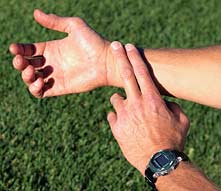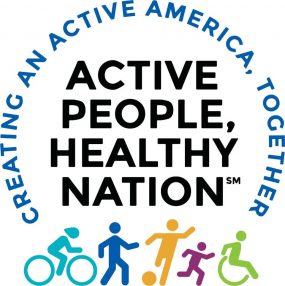Target Heart Rate and Estimated Maximum Heart Rate
One way of checking physical activity intensity is to determine whether your pulse or heart rate is within the target zone during physical activity.1
For moderate-intensity physical activity, your target heart rate should be between 64% and 76%1,2 of your maximum heart rate. You can estimate your maximum heart rate based on your age. To estimate your maximum age-related heart rate, subtract your age from 220. For example, for a 50-year-old person, the estimated maximum age-related heart rate would be calculated as 220 – 50 years = 170 beats per minute (bpm). The 64% and 76% levels would be:
- 64% level: 170 x 0.64 = 109 bpm, and
- 76% level: 170 x 0.76 = 129 bpm
This shows that moderate-intensity physical activity for a 50-year-old person will require that the heart rate remains between 109 and 129 bpm during physical activity.
For vigorous-intensity physical activity, your target heart rate should be between 77% and 93%1,2 of your maximum heart rate. To figure out this range, follow the same formula used above, except change “64 and 76%” to “77 and 93%”. For example, for a 35-year-old person, the estimated maximum age-related heart rate would be calculated as 220 – 35 years = 185 beats per minute (bpm). The 77% and 93% levels would be:
- 77% level: 185 x 0.77 = 142 bpm, and
- 93% level: 185 x 0.93 = 172 bpm
This shows that vigorous-intensity physical activity for a 35-year-old person will require that the heart rate remains between 142 and 172 bpm during physical activity.

Generally, to figure out whether you are exercising within the target heart rate zone, you must briefly stop exercising to take your pulse. You can take your pulse at your neck, wrist, or chest. We recommend the wrist. You can feel the radial pulse on the artery of the wrist in line with the thumb. Place the tips of the index and middle fingers over the artery and press lightly. Do not use the thumb. Take a full 60-second count of the heartbeats, or take for 30 seconds and multiply by 2. Start the count on a beat, which is counted as “zero.” For example, if this number falls between 109 and 129 bpm in the case of a 50-year-old person, he or she is active within the target range for moderate-intensity activity.
- Deborah Riebe, Jonathan K Ehrman, Gary Liguori, Meir Magal. Chapter 6 General Principles of Exercise Prescription. In: ACSM’s Guidelines for Exercise Testing and Prescription. 10th Ed. Wolters Kluwer/Lippincott Williams & Wilkins, Philadelphia, PA: 2018, 143-179.
- Physical Activity Guidelines Advisory Committee [PDF-4.6MB]. Physical Activity Guidelines Advisory Committee Report, 2008. Washington, DC: U.S. Dept of Health and Human Services; 2008.

